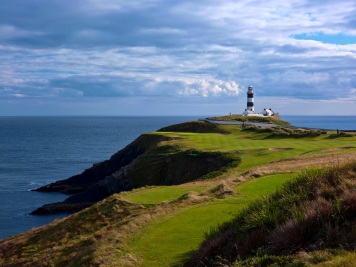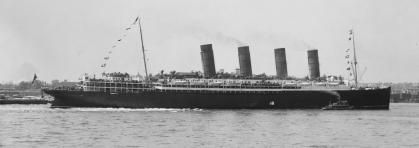
RMS Lusitania which won the Blue Riband for the fastest crossing of the Atlantic by a liner. She was torpedoed 11 miles off the Old Head of Kinsale on 7th May 1915.
With the commencement of World War I commemorations in 2014, it is appropriate to mention a local commemoration in the south-east Cork area. Cobh, formerly Queenstown, will commemorate the centenary of the sinking of the RMS Lusitania. This fast passenger liner, en route from New York to Liverpool, was torpedoed about 11 miles off the Old Head of Kinsale by U-20 shortly after 14.10 hours on 7th May 1915. What happened next is debated, but the ship sank so rapidly that only that only six of her lifeboats could be launched successfully. Of the 1959 passengers and crew aboard her, only 764 were rescued despite the best efforts of local Irish fishermen who sailed to assist.
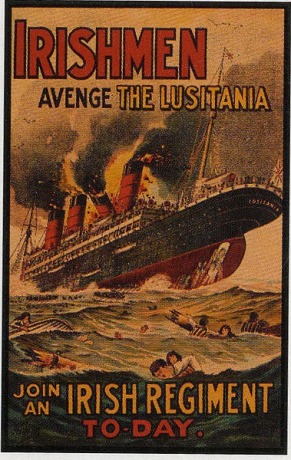
Recruiting poster issued by the British government for use in Ireland. The sinking of the Lusitania caused outrage in Ireland.
The Irish fishermen who went to assist the survivors did not have modern fishing vessels. Most of their boats were powered by sail or, more rarely, by a steam engine. This meant that they could be slow to get the the site, thus increasing the distress of the survivors struggling to combat hypothermia in the cold waters. Hypothermic shock was likely the biggest killer of the survivors – the seas around Ireland can remain cold until June – and even then they need a long spell of warm weather to make the water just about bearable.
Most of the survivors were conveyed to Queenstown, the principal base for the Royal Navy on the south coast of Ireland, and the center commanding the rescue operations. In Queenstown, the survivors were cared for in hospitals and lodged in hotels and guest houses. In the days following the sinking, bodies washed ashore all over west Cork, but most of the bodies that were recovered were interred in mass graves in Queenstown, although a small number were interred in Kinsale, which was closer to the site of the sinking. The majority of the victims were never recovered.
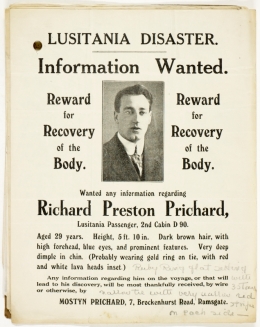
Most of the victims of the Lusitania were never recovered. This poster shows how desperate people were to recover just the remains of their loved ones.
At the time the US newspapers published details of the ship’s manifest and munitions and war materiel were clearly stated to be aboard the ship. However in Britain and Ireland this information was suppressed. Indeed many people in Ireland remain ignorant to this day of the RMS Lusitania’s official status as an Auxiliary Merchant Cruiser – she was so listed in Jane’s Naval Ships in 1914. The Lusitania was not just built with private funds – but her construction and operations were subsidized by the British government (RMS means Royal Mail Ship – the Lusitania was contracted to carry letters and parcels for the Royal Mail – a useful subsidy).
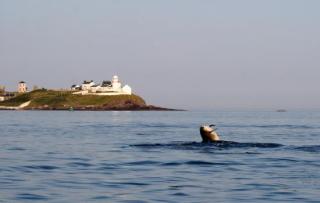
Roches Point lighthouse, not far from Midleton, marked the nearest safe haven for a vessel the size of the Lusitania – Cork Harbour. On her maiden voyage, Lusitania, like Titanic, stopped offshore to take on passengers from Queenstown.
One controversy about the Lusitania concerns the ‘second explosion’. Kaiptanleutnant Walther Schwieger, commander of U-20, recorded that he only fired one torpedo and was reluctant to fire a second in the the struggling mass of humanity struggling in the water. Yet there was a second explosion – this is clear now. It wasn’t widely known when I was growing up. Yet, I have personal testimony that supports one view of the sinking. Years ago we had a neighbour, Mr Patrick Donovan, who was a retired Garda (Irish police officer). Pat grew up near the coast not far from the Old Head of Kinsale. Once, when I visited him in the late 1980s, he told me of his experience the sinking of the Lusitania. His memory was slightly hazy about the events of May 1915, but only slightly – this man remained lucid to the end of his life, and he was very clear on certain points.
I’ll give you the gist is his own words – they are still very vivid to me. One point to remember, dinner in rural Ireland was then eaten in the middle of the day (and this is still the case for a lot of people). That was the first thing he said – ‘it happened just as we were finishing our dinner. We heard an explosion. We knew it came from the sea so we ran out of the house up a nearby hill to look. As we left the house there was a second explosion. When we got to the top of the hill we saw on the horizon a big ship sinking. it was gone in about five minutes.’
Needless to say I was taken aback by this so I asked him – are you sure there was a second explosion? The history books say there was only one torpedo.’ ‘Tony,’ he said ‘the books are wrong – I was there and there were two explosions. I heard a second explosion. We all heard the second explosion. The first one got us up from the table and the second happened as we ran from the house.’
Why do I remember this conversation so vividly? Simple, my neighbour had contradicted everything I knew about the Lusitania – and he was very clear about the second explosion. Curiously it would be several years before the story of the second explosion became more widely known and the theories that were put foward ranged from a coal dust detonation to suspicion of munitions going off.
The British hoped that the loss of so many American lives aboard he Lusitania would propel he US into the war – this has led to speculation that Winston Churchill as First Lord of the Admiralty had deliberately put the ship in harm’s way to achieve an American entry into the war. I think it seems too farfetched – the Lusitania was a fast vessel, having held the Blue Riband for the fastest crossing of the Atlantic. It was assumed she would outrun any submarine. But she couldn’t outrun a submarine that just accidentally stumbled upon her. She was simply in the wrong place at exactly the wrong time.

The Lusitania Memorial in Cobh, by Jerome Connor, with stone carved by Seamus Murphy, is actually unfinished. In a way it is oddly appropriate since the ship didn’t complete her voyage in May 1915. The two figures at the front commemorate the fishermen who rescued survivors and retrieved bodies.
Keep you eyes open for the commemorative events in Cobh this year!
Some links about the commemorations:
http://www.irelandcork.com/cobh-attractions-summary.php?ID=49&sc=12
